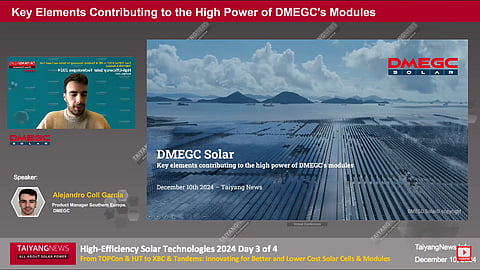

DMEGC has adopted a rear poly-finger TOPCon cell structure which improves cell short-circuit current (Isc) significantly
The company has also incorporated half edge passivation technology for passivating edges of laser-cut half-cell to enhance cell Voc
At the module level, the company is offering anti-glare modules for airport or highway applications, while its AgriPV module series awaits certification
The challenging global photovoltaic (PV) market, characterized by plummeting prices and overcapacity, has prompted a few TOPCon module manufacturers to innovate. These advancements include developing specialized products such as anti-glare and agrivoltaic (Agri-PV) modules, as well as improving cell technology to stay competitive.
At the recent TaiyangNews Annual Flagship Conference – High-Efficiency Solar Technologies 2024 – Alejandro Coll Garcia, Product Manager Southern Europe at DMEGC, highlighted the progress in the TOPCon cell and special-application modules (see DMEGC presentation here). Based in China, DMEGC has 6 manufacturing bases including Hengdian, Sihong, Qixian, Yibin, Lianyungang, and Indonesia, with an annual PV cell and module capacity of 23 GW and 21 GW, respectively. Additionally, in line with the company’s zero-carbon emission sustainable development goal, the PV module manufacturing units operate on 100% renewable energy, while the PV cell factories are transitioning to 100% green energy. Notably, DMEGC’s all modules and packaging are PFAS-free.
The company offers a range of cell sizes, including M10 (182.2 x 182.2 mm), M10R (182 x 187.5 mm), G12 (210 x 210 mm), and G12R (182 x 210 mm), and is continually advancing its cell technology. Recently, DMEGC’s TOPCon cell, which achieved up to 26.7% efficiency in the lab setting, has incorporated several technological enhancements, such as the rear poly-finger cell structure and half-edge passivation.
The rear poly-finger TOPCon cell structure, which includes laser ablation of the non-grid polysilicon layer followed by additional processing steps, effectively increases the short-circuit current (Isc) by reducing parasitic absorption in the non-contact polysilicon layer. This improvement resulted in a relative Isc gain of up to 0.11%, which corresponds to a 0.15% increase in relative efficiency, says DMEGC.
Additionally, the half-edge passivation (HEP) technology, which deposits an AlOx film via atomic layer deposition (ALD) on the laser-cut cell edges, effectively passivates the cutting edges and improves the cell’s open-circuit voltage (Voc). Internal testing by DMEGC shows that the adoption of HEP technology on the bifacial poly TOPCon structure boosted Voc by up to +15 mV and increased Pmpp by +3.6 W compared to the baseline.
In addition to the mainstream module series – iNFINITY and iNFINITY RT – DMEGC has developed special application modules – anti-glare module and Agrivoltaic (AgriPV) or Greenhouse (GH) modules.
The anti-glare bifacial module series, iNFINITY RT DMxxxG12RT-B66HSW, featuring anti-glare glass, features lower module reflection at different incident angles between 10° and 70° compared to conventional DMEGC bifacial modules. This module, boasting a power output of up to 635 W and an efficiency of up to 23.5%, is suitable for utility applications on highways or airports, added DMEGC.
The AgriPV or GH application module, available in various sizes and power classes, is expected to receive full certification from abZ in accordance with construction material standards. These modules, featuring different frame designs including Y-frame, ECG frame, and 16 mm frame, can be combined with different buildings such as Agri-PV integrated application with mainstream greenhouse structure, noted DMEGC.
Furthermore, DMEGC follows strict internal module quality control standards such as comprehensive IEC certifications, extended stress testing according to IEC TS 63209-1, and hail testing.
